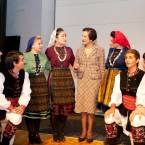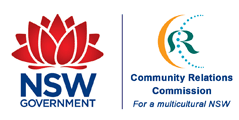Written by Mendo Trajcevski, Director, Port Kembla Macedonian Welfare Association Inc.
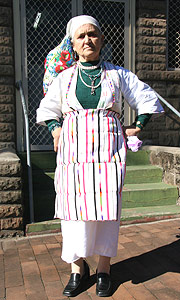 |
Many Macedonian migrants come from a village background where self-sufficient farming was a way of life for centuries. Clothing too was made by the women from wool shorn from their flock, which is then cleaned, dyed, spun and turned into yarn before being woven on a loom to make cloth. Young women were expected to make their wedding dress this way which always included an apron. The apron is an integral part of the dress and one can tell from which part of Macedonia people come from by looking at the colour and pattern of the apron.
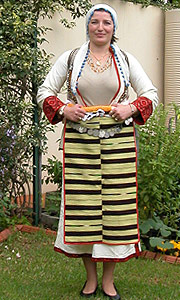 |
Some women wore traditional dresses in their village up to the moment they migrated to Australia 30 to 40 years ago. Once in Australia these original dresses and aprons were hidden, only to be seen on special occasions.
Many of these aprons are captured in old photographs shown in ‘Kompas’ magazine, published by the Macedonian Welfare Association Inc. It was these photographs that caught the attention of Meredith Walker, a heritage consultant and admirer of aprons.
Meredith wanted to know more about Macedonian aprons brought to Australia and with her assistance, the Macedonian Welfare Association Inc. formed a partnership with the NSW Migration Heritage Centre, with advice from the Illawarra Migration Heritage Project Inc., to do a “search” for old Macedonian aprons in the Illawarra region. The Association held a workshop, in Macedonian, at Port Kembla to document aprons and migration and settlement memories with support from Powerhouse Museum Regional Services. It scanned private and community owned photographs of people wearing aprons in Macedonia and Australia.
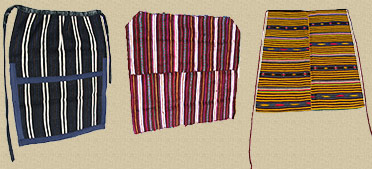 |
The project aimed to document the story of each apron, how it was made, by whom, the significance of the colours and pattern, when was it worn, by whom, the region or village it comes from and how it came to Australia and the Illawarra. The Association collected information about the design of as many village aprons as possible. Information collected, and photos of the aprons, became a web exhibition produced on the NSW Migration Heritage Centre’s website. It included an illustrated essay comparing and analysing the aprons.
Project Contact
Mendo Trajcevski
Director, Port Kembla Macedonian Welfare Association Inc.
Tel: 02 4275-2266
Address:
Macedonian Welfare Association
PO Box 101
Port Kembla NSW 2505
